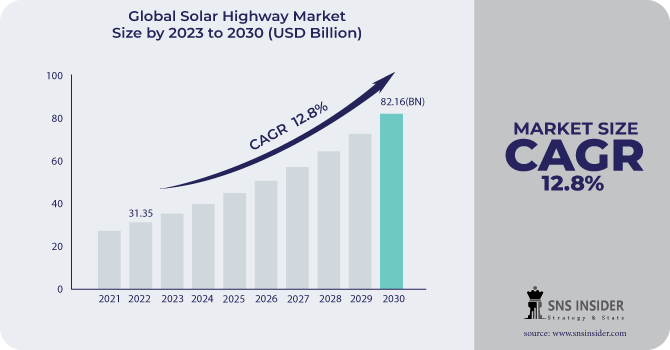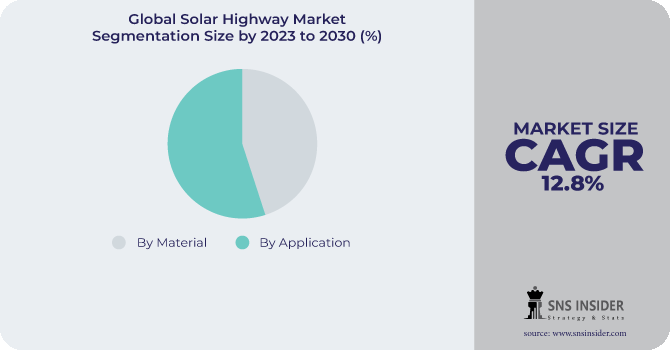Solar Highway Market Report Scope & Overview:
The Solar Highway Market size was valued at USD 31.35 billion in 2022 and is expected to grow to USD 82.16 billion by 2030 and grow at a CAGR of 12.8 % over the forecast period of 2023-2030.
A solar highway uses photovoltaic cells installed on specifically constructed driveways and highways to absorb solar energy. Due to its high manufacturing costs and the scarcity of materials and service suppliers throughout the world, solar highway is a costly technology.

Get More Information on Solar Highway Market - Request Sample Report
The solar highway is a system that combines a driving surface made of transparent sun cells with sensors, electronics, and electronics to work with solar array circuits. Road panels for solar highways are constructed specifically from recycled materials, and the surface of the road is covered with PV cells. The main goal of the development of the solar highway was to use lengthy roads to provide clean, renewable energy. The same solar highway concept may be used for playgrounds, swimming pools, and courtyards. Solar panels are found on solar roads.
MARKET DYNAMICS
KEY DRIVERS:
-
Growing Demand for Renewable Energy
-
Increasing concern for the environment
Due to substantial developments in solar technology and rising demand for renewable energy sources, particularly solar energy, the solar highway industry is anticipated to grow rapidly in the next years also, enhanced R&D from large corporations.
RESTRAIN:
-
Cost of making is very High
-
Repairing of Solar panels is costly
OPPORTUNITY:
-
Increasing research activities
-
Increasing fund and FDI investments
Growing funding, research activity, and FDI investment Highways for solar energy, particularly in France, the U.S., and China, are expected to present major opportunities for solar energy makers.
CHALLENGES:
-
The cost of producing unique type surface panels made of glass is relatively expensive
IMPACT OF RUSSIAN UKRAINE WAR
The world solar business has been significantly impacted by the Russia-Ukraine conflict. Both nations are significant players in the solar sector, with Russia and Ukraine each contributing around 3% and 8%, respectively, of worldwide output. Prices for both raw materials and finished goods have increased, disrupting many firms' supply chains. Since both nations are key players in the wind and solar sectors, the war has also had a significant negative impact on the renewable energy industry. Prices for both raw materials and completed goods have increased significantly as a result of the fighting, which has also affected the supply chain for many firms. This has impacted the remainder of the renewable energy industry.
IMPACT OF ONGOING RECESSION
The capacity of many nations to deliver alternative energy sources to the rural poor, who now rely on conventional fuels, is likely to be delayed by the economic recession. They will have to rely increasingly more on their conventional energy sources as these places' populations and energy needs grow. When extra energy might have been produced using renewable energy sources like hydropower, solar power, and wind power instead of cutting down more trees, the outcome will be carbon emissions. The present recession is also likely to hurt the environment and the underprivileged in this way.
KEY MARKET SEGMENTATION
By Material
-
Monocrystalline Silicon
-
Polycrystalline Silicon
By Application
- Driveways
-
Parking Lots

Get Customised Report as per Your Business Requirement - Enquire Now
REGIONAL ANALYSIS
The Asia Pacific solar highway market is anticipated to grow quickly throughout the forecast period. During the projected period, rising power consumption in China, Japan, and South Korea is anticipated to drive up demand for solar highway.
Additionally, the building and construction industry in developing nations in Asia Pacific, including China, India, Indonesia, and Vietnam, is expected to see an increase in demand for solar photovoltaic panels for parking lots, creating lucrative opportunities for regional solar highway providers.
During the projection period, Europe is anticipated to trail Asia Pacific in terms of market share for solar highways due to increased R&D spending in the sector.
REGIONAL COVERAGE:
North America
-
US
-
Canada
-
Mexico
Europe
-
Eastern Europe
-
Poland
-
Romania
-
Hungary
-
Turkey
-
Rest of Eastern Europe
-
-
Western Europe
-
Germany
-
France
-
UK
-
Italy
-
Spain
-
Netherlands
-
Switzerland
-
Austria
-
Rest of Western Europe
-
Asia Pacific
-
China
-
India
-
Japan
-
South Korea
-
Vietnam
-
Singapore
-
Australia
-
Rest of Asia Pacific
Middle East & Africa
-
Middle East
-
UAE
-
Egypt
-
Saudi Arabia
-
Qatar
-
Rest of Middle East
-
-
Africa
-
Nigeria
-
South Africa
-
Rest of Africa
-
Latin America
-
Brazil
-
Argentina
-
Colombia
-
Rest of Latin America
RECENT DEVELOPMENTS
-
PLI was not the only proposal made by MNRE in 2021; a Basic Customs beginning on April 1, 2022 (BCD). For the import of cells, BCD would apply in the amounts of 25% and 40%, respectively. Here is a substantial tax that might make domestically produced modules competitive with or even less expensive than imported goods. The BCD has not yet taken effect, and it is highly probable that once it does, solar project costs and LCOE will rise. It is unclear if this will cause deployments to be delayed in 2022 and 2023 since entirely locally produced modules won't yet be accessible in large enough numbers.
KEY PLAYERS
The Major Players are Solar Roadways Inc., Shandong Pavenergy, Wattway, Canadian Solar Inc., Colas Group, Onyx Solar Energy, Photovaltaic Pavement, Tolar HashNet, Road Energy Systems, TGD Solar, Electreon, SolaRoad Inc., SunPower Corporation, TsO, Esolar Inc., Wuxi Suntech Power Co. Ltd., and other players are listed in a final report.
Shandong Pavenergy-Company Financial Analysis

| Report Attributes | Details |
| Market Size in 2022 | US$ 31.35 Bn |
| Market Size by 2030 | US$ 82.16 Bn |
| CAGR | CAGR of 12.8 % From 2023 to 2030 |
| Base Year | 2022 |
| Forecast Period | 2023-2030 |
| Historical Data | 2020-2021 |
| Report Scope & Coverage | Market Size, Segments Analysis, Competitive Landscape, Regional Analysis, DROC & SWOT Analysis, Forecast Outlook |
| Key Segments | • By Material (Monocrystalline Silicon, Polycrystalline Silicon) • By Application (Driveways, Parking Lots) |
| Regional Analysis/Coverage | North America (US, Canada, Mexico), Europe (Eastern Europe [Poland, Romania, Hungary, Turkey, Rest of Eastern Europe] Western Europe] Germany, France, UK, Italy, Spain, Netherlands, Switzerland, Austria, Rest of Western Europe]). Asia Pacific (China, India, Japan, South Korea, Vietnam, Singapore, Australia, Rest of Asia Pacific), Middle East & Africa (Middle East [UAE, Egypt, Saudi Arabia, Qatar, Rest of Middle East], Africa [Nigeria, South Africa, Rest of Africa], Latin America (Brazil, Argentina, Colombia Rest of Latin America) |
| Company Profiles | Solar Roadways Inc., Shandong Pavenergy, Wattway, Canadian Solar Inc., Colas Group, Onyx Solar Energy, Photovaltaic Pavement, Tolar HashNet, Road Energy Systems, TGD Solar, Electreon, SolaRoad Inc., ‘SunPower Corporation, TsO, Esolar Inc., Wuxi Suntech Power Co. Ltd. |
| Key Drivers | • Growing Demand for Renewable Energy • Increasing concern for environment |
| Market Restraints | • Cost of making is very High • Repairing of Solar panels is costly |

